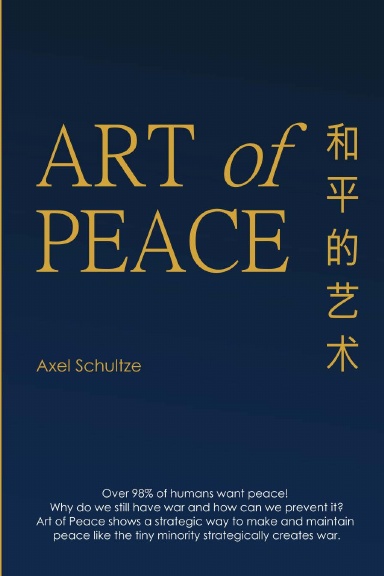Strategy to make and maintain peace
Created using methodologies from the innovation space and Artificial Intelligence to solve this problem.
Interesting Facts
- 99% of adults do not want to have war.
Only less than 1% lack empathy and a sense for human lives. - A country can only start a war with the support of its population.
Highly complex propaganda is needed to win the necessary support for a war. But without the population, there is no war. - Part of propaganda is convincing people through unsubstantiated evidence that war helps humanity to advance.
- Countries sell their old weapons to finance new arms development.
Yet they know that they cause thousands or millions of deaths. - Military alliances are the reason why global wars can be ignited. And large alliances are no guarantee for peace. Moreover there is a risk that an aggressor can abuse their alliances to represent a free of charge army.
- Without the help of Artificial Intelligence, this book would not be possible.
Art of Peace is at first about making peace, then maintain peace.
The objective of this book is to find a way to end wars and embrace peace. It is done without finger-pointing or making people or governments guilty. We can’t change history. The future is the only timeframe we can influence.
Homo Sapiens survived through their ability to cooperate and collaborate. Homo Sapience only accelerated to prosperity during peaceful times. Peace is a necessity to advance further and in more diverse collaboration models. Moreover, by analyzing the most significant advantages of peace, we came across a phenomenon of rapid human advancement: During the past 50 years of peace, the west advanced faster and further than any time before. But only the “West” Silicon Valley exploded at that time to advancement. Today it is in decline, and the wars killed the most advanced tech space. Probably the most significant transformation in the protection of peace made China. Without any development aid, China grew from one of the poorest nations to the leading nation in the world.
Reasons for peace is also an Art of Peace
The understanding that peace is the biggest amplifier for growing the potential of a peace embracing nation is the biggest reason for making and maintaining peace.
The most advanced nations can only reach their maximum potential –
when all other nations reached theirs.
It doesn’t matter how much the potentials differ.
We need to allow all nations to find their own way and their own potential. Otherwise, we continue slavery and colonialism, even if we try to be helpful with development aid.
AI was an essential tool to write this book.
A strange companion helped find the strategy for “Art of Peace”, Artificial Intelligence. The author, Axel Schultze, is highly experienced in innovative thinking and solving problems of almost any complexity. The work lead to a three-prong approach
1) finding a reason for making peace
2) creating a strategy for peace
3) looking for a path to maintaining peace
This highly provoking, compelling, and in many ways, a surprising path may make people wonder why we do not talk about the lives we can save and the peaceful way we can live and so forth. Well, this is an outcome, but it did not lead to peace – not in the past 30,000 years.
Art of Peace is similarly rational and straightforward to its counterpart, Art of War. A neuroscientific method for problem-solving and an AI system for assessing all the facts have been vital in finding an attractive solution. Many great thoughts and aspects have been provided before. But we did not have a Reason for Peace. Humans do things for a reason and don’t act if there is no reason, no matter how obvious things are. Art of Peace puts it together like a giant puzzle, forming the critical reason, a strategy to get there, and a way to maintain the status by continuously moving forward.




